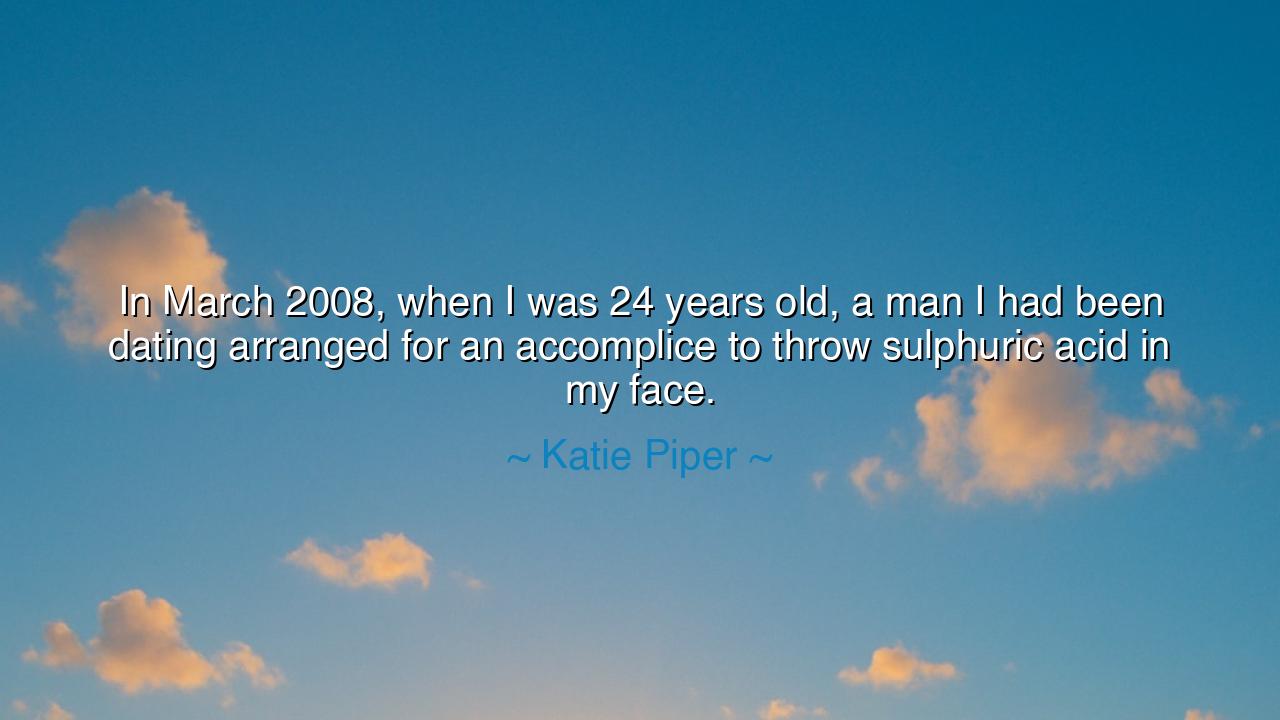
In March 2008, when I was 24 years old, a man I had been dating
In March 2008, when I was 24 years old, a man I had been dating arranged for an accomplice to throw sulphuric acid in my face.






In a voice that has walked through fire and chosen to speak, Katie Piper declares: “In March 2008, when I was 24 years old, a man I had been dating arranged for an accomplice to throw sulphuric acid in my face.” The sentence is spare as a courtroom oath and heavy as a bell toll. Its meaning is layered: a timestamp of harm, a naming of betrayal, a recognition that violence can wear the mask of intimacy. In a few unadorned words she maps the road from trust to treachery and then—by telling it—begins the longer road back from silence to dignity.
Attend to each shard of the line. March 2008 fixes the grief in time, so that it cannot blur into myth. Twenty-four marks a life still unfolding, a threshold age where futures are chosen, not stolen. “A man I had been dating” reveals the wound within the hearth: danger not in some distant alley, but near, with a smile and shared plans. “Arranged for an accomplice” unveils premeditation—the violence was not heat, but cold; not accident, but architecture. “Sulphuric acid… in my face”: a poison chosen to punish visibility, to mar identity, to make the mirror an enemy. In the style of the ancients, we would say: the body was attacked, but the assault aimed at the person—at presence itself.
Thus the origin of the quote is witness and indictment in one. It comes from a survivor recounting the moment that divided a life into before and after, a life that then turned toward long surgery, long healing, and the longer labor of transforming private hurt into public warning and help for others. In speaking, she resists the erasure that such crimes intend. She refuses the script that would make the victim vanish into statistics. Her sentence does not beg pity; it demands attention, reform, and a re-education of what love is and is not.
The meaning widens beyond one life. This is a parable of gendered violence, of control that, when thwarted, seeks to disfigure rather than to persuade; a lesson in how coercion can escalate when boundaries are enforced. The quote teaches us to take threats seriously, to recognize that charm can coexist with danger, and to understand how cultures that trivialize stalking, jealousy, or possessiveness till the soil in which such acts sprout. It also teaches that beauty must be redefined: not as symmetry of skin but as the radiance of survival, agency, and chosen kindness after cruelty.
A real-world mirror reinforces the point. In India, Laxmi Agarwal survived an acid attack as a teenager and later became a public advocate whose courage helped spur tighter controls on acid sales and greater protections for survivors. Her work—like Piper’s testimony—turns one person’s darkest hour into a lantern for many. History is braided with such lantern-bearers: individuals who refuse to be reduced to the harm done to them, and who remake the law and the culture by insisting that what happened is not merely personal misfortune but a public failure that can be remedied.
From this we draw an elder’s lesson: naming the wound is the first act of healing, and the first brick in a safer city. Survivors are not problems to be pitied; they are teachers. Their stories recalibrate our instincts: to believe early, to intervene wisely, to design systems that make it hard to hurt and easy to get help. The sentence “In March 2008…” becomes a calendar-marked command: let there be fewer such dates. Let future Marches hold festivals for lives left unscarred.
Practical counsel follows. For individuals: learn the red flags—isolating you from friends, monitoring devices, volatile jealousy, threats disguised as jokes—and act early; document, confide, seek counsel, and leave in safety, not in haste. For communities: fund shelters and burn-care networks; train police and courts in coercive control; regulate and track the sale of corrosives; protect privacy and safety for those seeking help. For media and bystanders: center survivor voice, avoid lurid detail, refuse to turn cruelty into spectacle; practice the small, stubborn solidarities—meals, rides, advocacy—that make recovery livable.
Finally, receive the quote as both wound and vow. It names a day of undoing; it also inaugurates a resilience that refuses to be defined by an attacker’s choice. Let us answer it with works worthy of its courage: laws with teeth, neighborhoods with eyes and open doors, friendships that take warning signs seriously, and a new catechism for love—one that prizes consent, steadiness, and care. Then the testimony of Katie Piper will be more than memory; it will be the seed of many unbroken faces, many untaken harms, and many lives free to turn their own dawns toward joy.






AAdministratorAdministrator
Welcome, honored guests. Please leave a comment, we will respond soon